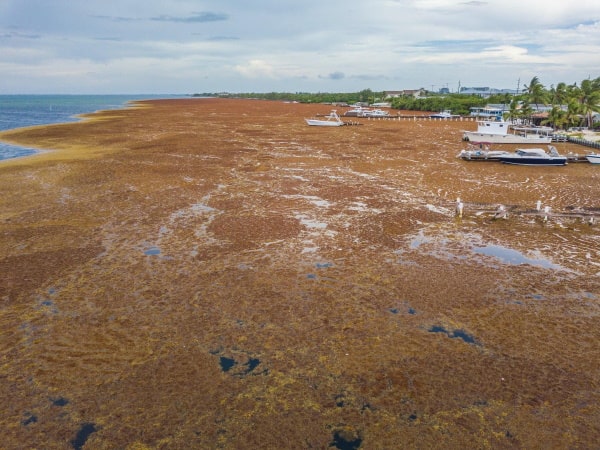[ad_1]

(CNS): Scientists have discovered that a flesh-eating bacteria is interacting with sargassum and decaying plastic in the ocean, creating the perfect “pathogen” storm that has implications for both marine life and public health. Researchers at Florida Atlantic University have found that the bacteria might be adapting to plastic and living in sargassum, washing up on beaches in a new environmental horror.
The seaweed has already been washing up on local shores over the last few weeks. Given the current size of the Atlantic sargassum belt, dubbed the “great blob”, as it has grown to reach some 5,500 miles across and is currently moving through our region, we can expect to see much more in the coming months.
It is already a major problem for the tourism sector, as visitors complain about the smell and efforts to get rid of it cause beach erosion. The mass of seaweed doubled every month between November and January, according to the University of South Florida’s Optical Oceanography Lab, which tracks the mass, and a new record for sargassum was set in the Caribbean Sea in April.
The Vibrio bacteria, which is now colonising the blob, is found in the ocean the world over and already poses a significant threat, but little is known about the ecological relationship of vibrios with the seaweed and the degrading plastic.
“Plastic is a new element that’s been introduced into marine environments and has only been around for about 50 years,” said Tracy Mincer, PhD, corresponding lead author and an assistant professor of biology at FAU. “Our lab work showed that these Vibrio are extremely aggressive and can seek out and stick to plastic within minutes. We also found that there are attachment factors that microbes use to stick to plastics, and it is the same kind of mechanism that pathogens use.”
The study, published in the journal Water Research, illustrates that open ocean vibrios represent an up-to-now undescribed group of microbes, some representing potential new species, possessing a blend of pathogenic and low nutrient acquisition genes, reflecting their pelagic habitat and the substrates and hosts they colonise.
The study highlighted vertebrate pathogen genes closely related to cholera and non-cholera bacterial strains. Researchers also discovered toxin or “zot” genes, which increase intestinal permeability as the vibrios appear to be getting in through the gut, getting stuck in the intestines and infecting that way.
“Another interesting thing we discovered is a set of genes called ‘zot’ genes, which causes leaky gut syndrome,” said Mincer. “If a fish eats a piece of plastic and gets infected by this Vibrio, which then results in a leaky gut and diarrhoea, it’s going to release waste nutrients such nitrogen and phosphate that could stimulate sargassum growth and other surrounding organisms.”
Findings show some Vibrio spp. in this environment have an omnivorous lifestyle, targeting both plant and animal hosts in combination with an ability to persist in oligotrophic conditions. With increased human-sargassum-plastic marine debris interactions, associated microbial flora of these substrates could harbour potent opportunistic pathogens.
Importantly, some cultivation-based data show that beached sargassum appears to harbour high amounts of Vibrio bacteria.
“I don’t think, at this point, anyone has really considered these microbes and their capability to cause infections,” said Mincer. “We really want to make the public aware of these associated risks. In particular, caution should be exercised regarding the harvest and processing of sargassum biomass until the risks are explored more thoroughly.”
[ad_2]
Source link

